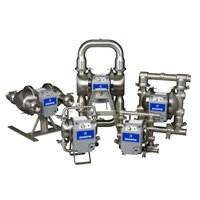Rotary Lobe Pump Advantages and Disadvantages vs EODD Pumps
What are the advantages and disadvantages of rotary lobe pumps compared to electric diaphragm (EODD) pumps?
What is the purpose of a rotary lobe pump?
Rotary lobe pumps are common in the manufacturing industry as a gentle, effective solution to handle a wide range of viscosities across various industries. These pumps, however, have limited compatibility with fluids containing chemistry and are susceptible to damage because of their complex design, which can lead to hazardous situations and high maintenance costs. Electric diaphragm pumps address these common issues.
Advantages of rotary lobe pumps
- High efficiency
Rotary lobe pumps are designed to provide a smooth and consistent flow for efficient fluid transfer, which makes them a good choice for industries where energy consumption is important. Even so, Graco’s electric diaphragm pump can cut energy usage and costs by up to 80%, providing an even lower cost. - Versatile
Rotary lobe pumps are able to handle a wide variety of liquids, including high viscosity materials. This makes them common choices for industries such as food processing, wastewater treatment, chemical processing, and other highly viscous fluids applications.
Disadvantages of rotary lobe pumps
- Reduced lift with thin liquids
Extra care is needed when selecting a rotary lobe pump for pumping thin non-lubricating liquids. All pumps have a small amount of liquid that goes from discharge back to suction. This is called slip, and it varies with liquid viscosity and differential pressure. Some rotary lobe pumps can be used with thin liquids, and most manufacturers offer several options to handle the low lubricity and viscosity typically associated with thin liquids, but it adds more complexity to the pump selection procedure and maintenance processes after installation compared to using electric diaphragm pumps. - High maintenance cost
Rotary lobe pumps have a number of rotating parts that need precision tolerances, which makes them more expensive to manufacture and maintain. Additionally, the rotating parts utilize expensive and sensitive seals that can easily lead to leaks if the pump is pushed beyond its performance and not properly cleaned or maintained over the service intervals. The QUANTM electric pump’s efficient and seal-less design ensures that it is not sensitive to wear and erosion and is easy to repair. - High investment costs
Rotary lobe pumps are designed with rotors, which are synced by a separate gear in the back of the pump. This increases manufacturing cost. Add to this the two relatively expensive mechanical seals and, not surprisingly, investment costs are high in comparison with other pump technologies on the market. - Unsatisfactory solution for abrasives
The rotary lobe pump’s intricate and sensitive design is not ideal for abrasives, which are bound to damage the system and its expensive parts. The pump’s lifecycle can be slightly extended by reducing pump speed and using hardened parts in key wear areas, but electric diaphragm pumps are clearly a better fit when you need higher flow and long-lasting durability. - Unable to run dry for extended periods of time
A rotary lobe pump cannot run dry without destroying its expensive stators and rotors due to the pumped fluid acting as a lubricator between the rotor and stator. QUANTM electric pumps can run dry without causing any damage to the system, avoiding expensive repairs.
Common applications of rotary lobe pumps
- Food and Beverage Industry
Due to the gentle pumping action and sanitary design, rotary lobe pumps are commonly used in the food and beverage processing industry for various applications. These applications include transferring liquids, handling viscous products like sauces and creams, and pumping delicate food items without damaging their texture or integrity - Pulp and Paper Industry
Common applications for rotary lobe pumps in the pulp and paper industry include metering and dosing chemicals, transferring adhesives and coatings, and transporting various high-viscosity fluids. It’s crucial to transfer slurries without damaging the pump or material. Air pockets in the system can impact its efficiency and may damage product. - Pharmaceutical Industry
The gentle product handling and precise flow of rotary lobe pumps makes them a common selection for various pharmaceutical manufacturing processes. These applications require safe transfer of sensitive materials, accurate metering of ingredients, and a consistent temperature to not impact the material being transferred.
Electric diaphragm pumps (EODD) vs rotary lobe pumps
Compared to a traditional rotary lobe pump, the QUANTM EODD provides much more flexibility and a significantly lower maintenance cost. Take a look at the benefits:
| Rotary lobe pumps | Graco QUANTM EODD pumps |
| Running dry will cause damage to the pump | Can run dry indefinitely |
| High repair cost for spare parts | Easy to repair at low cost |
| High investment cost | More cost-effective, especially for larger flow rates |
| Deadhead/stall causes severe damage | Easily deadheads/stalls with no additional equipment |
| Abrasive-containing fluid can quickly cause failure | Easily handles all fluids with abrasives |
| Shaft alignment difficult to maintain | No spinning shaft seals; no alignment necessary |
| Very expensive for larger flow rates | Can handle large bulk flow rates |
| Minimal suction capability | Self-priming pump with smooth flow |
| Not ideal for thin non-lubricating liquids or low viscosity fluids | Suitable for all types of fluids |
Quantm ROI Calculator
Interested in going electric?
Use this ROI calculator to determine how much you could save by converting your facility to Graco electric double-diaphragm pumps.
Related Articles
How Does a Diaphragm Pump Work?
Understand the working principle of a diaphragm pump, the different types of diaphragm pumps, and the common uses and applications.
Electric pumps lead the way to energy efficiency and sustainability goals
Electric pumps lead the way to energy efficiency and sustainability goals
Different Types of Pumps - Classifications and Applications
There are many different types of industrial pumps, including diaphragm pumps, gear pumps, peristaltic pumps, and more. See an overview of each.




